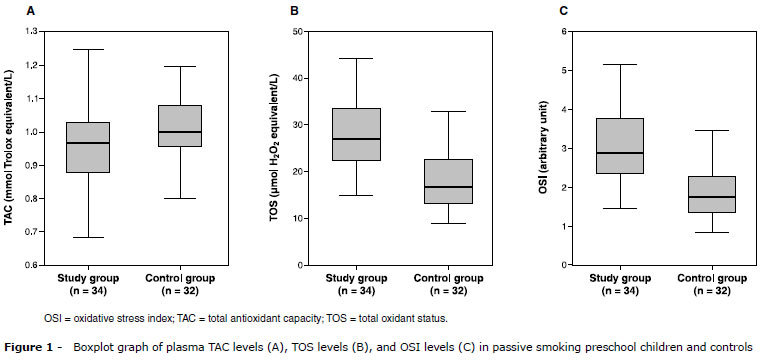OBJECTIVES: To study the effect of passive cigarette smoking on plasma oxidative and antioxidative status in passive smoking preschool children and to compare them with controls. METHODS: Thirty-four passive smoking (five to 50 cigarettes per day) preschool children (study group) and 32 controls who had never been exposed to cigarette smoke were randomly chosen from children aged from 4 to 6 years. Urinary cotinine and plasma indicators of oxidative and antioxidative status, i.e., total oxidant status (TOS), total antioxidant capacity (TAC), and oxidative stress index (OSI), were determined. RESULTS: Mean environmental cigarette consumption was 22±13 cigarettes per day in passive smoking children. Mean urinary cotinine levels were 77.6±41.4 ng/mL and 11.9±2.3 ng/mL in the study and control groups, respectively (p < 0.001). Mean plasma TAC levels were 0.95±0.13 mmol Trolox equivalent/L and 1.01±0.09 mmol Trolox equivalent/L, respectively (p = 0.039). Mean plasma TOS levels were 28.6±7.9 µmol H2O2 equivalent/L and 18.5±6.3 µmol H2O2 equivalent/L, respectively (p < 0.001). Mean OSI levels were 3.08±0.98 arbitrary units and 1.84±0.64 arbitrary units, respectively (p < 0.001). A small amount of cigarette smoke (five to 10 cigarettes per day) causes considerable oxidative stress. There were significant correlations between number of cigarettes consumed and oxidant status and OSI levels. CONCLUSIONS: Passive smoke is a potent oxidant in preschool children. Its deleterious effects are not limited just to heavy passive smoking, but also occur with exposure to small amounts of smoke.
Antioxidants; cotinine; oxidants; passive smoking; preschool children




